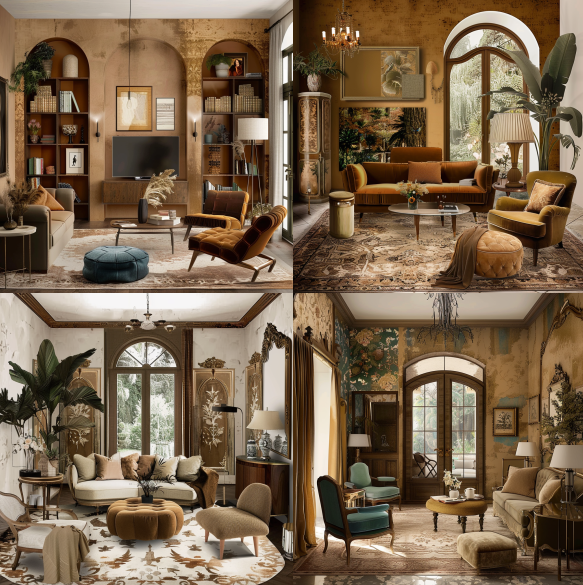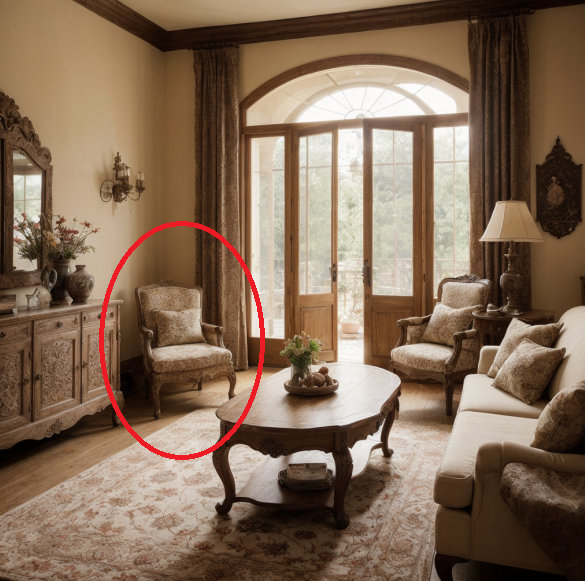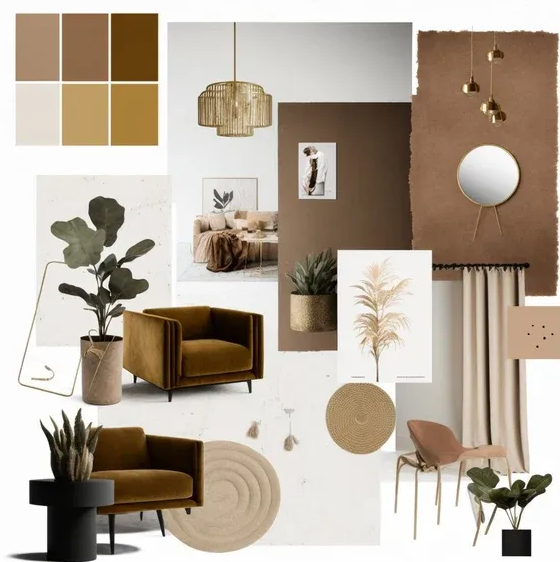Do you remember when Deep Blue, the AI by IBM, beat the Chess World Champion Garry Kasparov in 1997? The things people said then were roughly what many say now:
…AI will eliminate jobs, replace people, take over…
Despite the concerns, AI has grown exponentially. It’s used in business and in daily life. It’s everywhere.
AI interior design is a hot topic, too. It’s easy and satisfying to use generative AI to create lifelike, beautiful interiors.
The limitations of AI interior design are something to consider, though. Let’s look past the pretty pictures and discuss how an industry-leading design/build firm like ours uses AI, and why…

The main restrictions of AI
The AI industry jumped from around $136 billion in 2022 to $196 billion in 2023. AI tools are a part of everyone’s daily life, even if we don’t realize it.
We…
- Enjoy AI-based predictive text
- Use voice assistants like Siri and Alexa
- Tap into AI-bot-based customer service (whether we want a bot or not)
- See personalized, AI-generated news feeds and social media feeds
- Have AI-powered spam filters in every email account
- Get personalized streaming recommendations
The main restriction of AI is actually the result of its success. The number of tools has ballooned, and each is increasingly specific for certain tasks. (There are interior-design-specific AI tools, too.) Today, because of the number of tools, each AI is limited to the tasks it’s been given. Even if it can provide information on other topics, it’s only optimized for specific things.
Therefore, if you try to use a tool other than one optimized for interior design, you’ll get mediocre results. Even those AI tools MADE for the industry are still limited. And the implications are ones you will NOT like in your home.
Here are some image examples…

Ignore for a moment the overly brown palette in this space. Your first reaction might be, “hideous!” But there are other functional problems, too. …Do you see that chair in the corner? It’s too far away from the table for the person sitting in it to set down a drink. And, because of the placement of the rug, that chair can’t be scooted up more than a few inches.
Another HUGE functional problem here…the twilight is coming into the room, but clearly, it’s a dark space. And yet, there’s only one table lamp and one sconce…how could this space be properly illuminated at night?!

Another example…this space DOES have great natural light. However, without sconces or ceiling lights, how bright can it really be at night?
Next, what’s up with that table in the far left corner? It’s way too far from the couch for anyone sitting there to use it as a surface.
And the chair in front of the French doors?? What a disruptive place for the flow in and out of this room…
Finally…the ceiling molding is certainly interesting, but what is that deep recess about?? Can you imagine trying to clean that, or what could get caught up there?
Another grind about AI (and especially AI interior design) is its lack of creativity. Its models and algorithms are based on what information it’s been fed. Nothing it creates will ever be novel. By default, it’s reused and recycled. That’s the antithesis of what you want in your home…you want personality. Yours, to be specific!
The biggest limitation of AI, though, is its lack of knowledge.
…At least, knowledge that’s specific and relevant to you.
More on that in the next section…
What AI can versus can’t do in home design
Consider these five “this instead of that” models that better explain what AI is equipped for…
- Artistic rather than true-to-life:
AI images can be beautiful, and its text can be enlightening. It can inspire. It’s only inspiration, though, that AI is good for. Based on the examples above, you can see that AI is not equipped for “true-to-life” considerations for the flow of a room, the utility of cabinets, or the lifestyle implications of lighting, etc. - Design ideas rather than your design:
AI can give you specific ideas if you have a style you’re trying to achieve, or need more options for cabinet layouts. It can help you think of selections that you hadn’t yet added to your list. When it comes to creating a design for you in your space, though, only a selection-by-selection process with someone who’s consulted with you and can discern your wants, likes, and needs will do the trick. - Generic text rather than personalized text:
One of the things we do for every renovation and interior design project is provide daily updates to clients whose projects are in production. We tell clients what was done and what to expect in the coming days. That kind of update can’t be written by AI, because the work to teach the AI everything it needs to know is more time-consuming than writing the texts and emails ourselves. The kind of personalized care we provide in communications to clients will never be replaced by AI. - Market stats rather than market insights:
Our own CEO and Principal Designer, Robin Burrill, has been to a dozen industry events this year already. She toured High Point Market. She went to hands-on training at Middleby Residential. AI can talk about these events, but AI cannot give you insights like Robin can about the lifestyle implications of what she saw and learned. AI can’t give you an opinion, it just harvests what was shown. Robin, in contrast, shares what was learned. - Content ideas rather than content writing:
You’re in the middle of this article…and not one word has been generated by AI. We write articles and share content on our Facebook and Instagram profiles to educate and entertain. That requires examples from real projects we’ve done, and from our personal experience, and AI can only write about the larger industry.
Based on these limitations, we will NOT use AI for:
- True-to-life examples
- Real client designs
- Client communications
- Insights we share with you
- Content writing
If you’re a homeowner and you want to inquire with us about a project in your home, you want our real, personal consultation. You need to see examples from our portfolio. AI won’t be able to tell you why you should choose us or any other company. So, looking for your renovation partner will never be something AI can do for you.
What we WILL (and do) use AI for:
- Extra images to provide context or commentary on social media (for example, generating a design board based on a real project of ours that we feed the AI tool)
- Modifying real project images to share on social (for example, if a client selected one type of stove but we want to show the space with another, we can change it using AI)
- To showcase the impact of lighting decisions during design (however, our design programs do this, too…so this isn’t only done in AI)
- Simplifying material care tips, maintenance and warranty information for clients after projects are done
- Data processing (for example, Robin posts polls in her private design group every Monday…and AI helps us analyze everyone’s answers)
Look at some of these examples of AI-generated design boards. For us, these are fun to share on social media. For you, they provide great inspiration!


The ethical considerations of AI interior design
There are ethical considerations when using AI, too, which is one of the reasons we’ve put our practices down on paper. As a business, it’s our responsibility to look at every potential implication of using AI.
Because of the ethical implications, we:
- Will never share client data with any AI tool (because the private AI company then owns the data, and we can’t control what they use it for)
- We also won’t give our “secret sauce” away to AI tools (meaning we won’t use AI for anything that leverages our creativity, ingenuity, and expertise, because, once again, a private company can do whatever it wants with the data)
Have you thought of this angle yet?…
Now…how about the interior designers on your Insta feed using AI? How about the products you’ve seen that claim to elevate your home with AI-engineered interior design?
Be careful. An investment in your home is a huge undertaking emotionally and financially, and the kinds of lifestyle factors that AI doesn’t know how to consider will become a huge problem.
Just to drive this point home, let’s show another example…

This AI interior design image looks pretty crisp and clean at first. How about the dead space above the fridge, though? Those boxes should be cabinets for added storage. As for the cabinets that are pictured, the thin ones on either side of the fridge will be a huge problem next to the hinges of the fridge doors…that’s just bad engineering.
Finally, look again at the ceiling. There’s nice natural light coming in now, but where are the recessed lights? Kitchens require the best functional lighting, and this space would never cut it.
The only way to have your renovation or interior design project done with absolute functional optimization is to work with the right professional. If you see AI interior design filling your feed, look instead for credentials like the NARI Accreditation, NCIDQ certification, and Registered Interior Designers with your state.
…This is how WE use AI, and how we never will. Consider this a mini-manifest to look behind the curtain at Signature Home Services and the expertise that goes into what we do.
Now…another technology we’ll be using more of soon is virtual reality, but that’s another topic for another day!! Subscribe to our magazine to see what we write about next…


That means even more coming from a designer like you, Amy! Thank you for reading and sharing!
What a great post and I love how you showed the pros and cons, and how AI has it’s shortcomings, (that working with a designer will never have!) Brilliantly laid out, I love the way you tackled this topic!
Thank you, Leslie! That means a lot coming from you, with how much you’ve pioneered the design + AI space. It really is a fascinating topic!! We’re happy to share more with homeowners to help them navigate the new opportunities.
Hi Robin ~ This post is an excellent example of why it will always be smarter to hire an interior designer versus working exclusively with an AI enabled interior design bot on a platform of some type.
I’m so glad you wrote this, it truly highlights why humans will always be valuable and needed in the process of designing a home for real human beings.